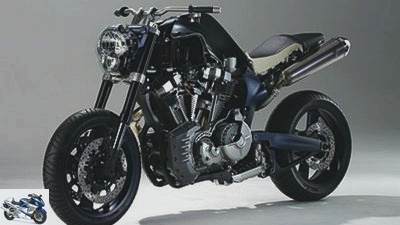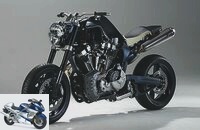Table of contents

Yamaha
counselor
technology & future
Technology innovation: Yamaha MT-01
Technology innovation: Yamaha MT-01
Genetic engineering
The heart of a fat cruiser implanted in a tight-fitting sports chassis, the whole thing garnished with the most necessary accessories? With the MT-01, Yamaha introduces a completely new motorcycle concept.
Waldemar Schwarz
10/06/2004
As Yamaha 1999 at the Tokyo Motor
Show the study MT-01 presented, the experts were upside down. With the
Martial-looking show bike, Yamaha for the first time bridged the gap between completely different motorcycle categories and merged the 1670 cm3 two-cylinder of the Road Star Warrior
a sporty aluminum chassis and components from the supersport shelf. And that study didn’t go away? as it often happens? in the drawer. From 2005, anyone can park the MT-01 in their garage for around 13,300 euros.
For its new task, the long-stroke 48-degree V-cylinder with a camshaft underneath and very long bumpers that operate four valves per cylinder via fork rocker arms had to put up with a few modifications. For example, the crankshaft slimmed down significantly to enable more spontaneous revving with the lower centrifugal mass. Also the secondary drive is no longer cruiser-like via toothed belts, but by means of a much more compact chain and moved from the left to the right side.
The periphery was also completely turned inside out. The airbox under the tank is quite generous with a volume of seven liters. And the exhaust gases are breaking new ground. Shortly after the two manifolds have been merged, they pass an exhaust control, as it made Yamaha popular in the sporty four-cylinder engines and is now state-of-the-art for the 1000cc super sports cars from Japan.
The speed-dependent change in the collector cross-section with the aid of a flap should not only increase the torque in the lower and medium speed range, but also prevent the large two-cylinder from misfiring. In addition, the current pollutant regulations require
their toll. After the exhaust control, a regulated catalytic converter cleans the exhaust gases before they pass through the optically
extremely dominant, megaphone-shaped titanium silencers escape into the open air. Because of the modified environment, the technicians had to work out completely new maps for ignition and injection. All measures have a positive impact on the balance sheet. The power increased by four to 90 hp at 4750 / min, the torque rose from 141 to 150 Newton meters at 3800 / min.
While the engine is still largely based on existing components, the chassis is completely new. The frame is back to a cast construction-
which has already proven itself in the YZF-R6 or the FZ6. As with the latter, the two halves made in die casting are screwed together on the steering head and in the area of the swing arm. In terms of production technology, this process is particularly cheap and offers a lot of creative freedom. The wall thicknesses can be ideally adapted to the forces that occur.
Without a single weld, the surface is smooth on the outside, while ribs on the inside ensure high rigidity. The V2 is screwed to the upper part of the frame on the cylinder heads. A two-part cast aluminum support bolted under the steering head and the swing arm bearing has an additional stabilizing effect. The swing arm with girder also relies on casting technology and consists of two halves. However, they are welded together.
The Yamaha developers did not skimp on the spring elements. At the front there is a completely adjustable upside-down fork with a 43 millimeter tube diameter, which is used in a similar form in the R1 super sports car. The brake system with radial brake cylinder, radially screwed, one-piece four-piston fixed calipers, also from the R1, and the 320 millimeter brake discs meet the highest supersport standards. The fully adjustable spring strut located under the gearbox is attached to the swing arm via lever
hinged. Cast wheels in the unusual four-spoke design with radial tires in the dimensions 120 / 70-17 and 190 / 50-17 complete the ensemble.
And the chassis geometry? With a 1525 millimeter wheelbase, it undercuts the Road Star Warrior by a full 14 centimeters, but does not come close to the typical naked bike values because of the expansive V2. At 65 degrees and 103 millimeters, however, the steering head angle and caster are on par with unclad big bikes. So it remains to be seen how
the MT-01 with its full tank beats about 255 kilograms in driving behavior.
It can surely compensate for the slightly lower power compared to the big naked ones with the higher torque, and if that’s not enough, Yamaha offers one of three tuning kits from the extensive performance program, which is approved for the road and the big one Block still
elicits some extra horsepower. At least with its dominant optics, the MT-01 exudes power and dynamism even when it is stationary, so you can look forward to the propagated synthesis of “intense torque feeling and sporty handling” in practice.
Buy complete article

Technology innovation: Yamaha MT-01
Genetic engineering
4 pages) as PDF
€ 2.00
Buy now
Related articles
-
manufacturer counselor Used purchase Buying advice: Yamaha MT-01 Second-hand advice: Yamaha MT-01 Buy used Yamaha MT-01 properly In flyweight fighters…
-
Technology of the new 600 super sports car
counselor technology & future Technology of the new 600 super sports car Technology of the new 600 super sports car New base The new 600 super athletes…
-
Second hand advice Yamaha Vmax
fact counselor Used purchase Second hand advice Yamaha Vmax Second hand advice Yamaha Vmax Max the last In 18 years of sales, the Vmax mutated into a…
-
Comparison test between Suzuki DL 1000 V-Strom and Yamaha TDM 900
Artist motorcycles Comparison test between Suzuki DL 1000 V-Strom and Yamaha TDM 900 Comparison test between Suzuki DL 1000 V-Strom and Yamaha TDM 900…
-
Gargolov motorcycles Review Yamaha FZ6 Fazer S2 Review Yamaha FZ6 Fazer S2 A touch of luxury Fazer friends watch out! From this year two FZ6 Fazers will…
-
Second-hand advice: Yamaha FZS 1000 Fazer, FZ1 Fazer, FZ1
archive counselor Used purchase Second-hand advice: Yamaha FZS 1000 Fazer, FZ1 Fazer, FZ1 Second-hand advice: Yamaha FZS 1000 Fazer, FZ1 Fazer, FZ1 Buy…
-
On the move: 250cc from Kawasaki, Suzuki and Yamaha
Jahn 45 pictures Jahn 1/45 Jahn 2/45 Reminisce: For many, a 250cc two-stroke was the first real motorcycle in the 70s. Jahn 3/45 Jahn 4/45 Jahn 5/45 Jahn…
-
Endurance test final balance: Yamaha YZF-R 125
jkuenstle.de motorcycles Endurance test final balance: Yamaha YZF-R 125 Endurance test final balance: Yamaha YZF-R 125 The Yamaha YZF-R 125 after its…
-
Optimization of the Yamaha XJR 1300
accesories Optimization of the Yamaha XJR 1300 Optimization of the Yamaha XJR 1300 Mass movement The heavy Yamaha XJR 1300 is not only very popular, but…
-
Holzer accesories Upgrade Yamaha FZ1 Fazer Upgrade Yamaha FZ1 Fazer Yamaha FZ1 Fazer Both Yamaha FZ1 models already shine with a high degree of…